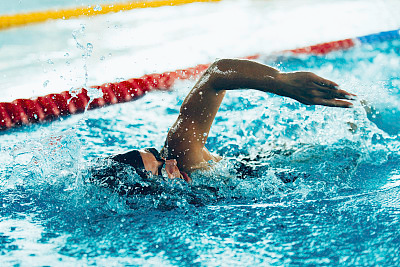Benefits of Swimming
Swimming is a skill-based activity performed in water that relies on buoyancy and coordinated body movements to propel the swimmer. Originating from humanity’s early struggle for survival, it has evolved into a widely practiced aerobic exercise suitable for different ages and fitness levels. Because the water supports body weight and provides uniform resistance, swimming simultaneously challenges the cardiovascular and musculoskeletal systems while remaining relatively gentle on the joints. As a result, it is an efficient form of exercise for improving overall health and well-being.
From a cardiovascular perspective, swimming trains the heart to pump more effectively. Repeated bouts of steady swimming strengthen the myocardium, enhance stroke volume, and improve cardiac output, thereby supporting more efficient metabolism. Well‑conditioned swimmers often exhibit a lower resting heart rate with stronger beats, a pattern reflecting athletic bradycardia rather than illness. In practical terms, the heart of an experienced swimmer can eject a comparable or greater volume of blood per beat than that of an untrained person at a higher heart rate, signaling improved cardiac efficiency over time. These adaptations arise with consistent, moderate training rather than extreme efforts and are best developed gradually.
Swimming also confers notable benefits to the respiratory system. Compared with most land-based sports, breathing control in water is more deliberate because the face is intermittently submerged and exhalation is often prolonged. This repeated management of inhalation and exhalation, coupled with the resistance of water, strengthens respiratory muscles and can increase functional lung volumes. Many regular swimmers demonstrate larger vital capacities and improved tolerance to transient hypoxia during effort. The capacity to ventilate efficiently allows for greater oxygen intake and more effective elimination of carbon dioxide during each breath, translating to improved aerobic performance and endurance.
The nervous system gains from swimming through enhanced coordination and faster neuromuscular responses. Because all major joints and muscle groups must work in synchrony, swimmers develop better motor control and timing, which can transfer to daily activities and other sports. The aquatic environment provides uniform resistance and sensory feedback, promoting smoother, more economical movement patterns. Over time, this integrated training improves agility and reaction time while encouraging balanced development of mobility and stability across the kinetic chain.
Musculoskeletal adaptations are a hallmark of regular swimming. The whole body is engaged, including the shoulders, back, core, and lower limbs, so swimmers often develop well-distributed muscle strength and endurance. The water’s resistance helps build lean mass while expending significant energy, making swimming a useful option for weight management in people seeking fat reduction without excessive joint loading. As fitness improves, individuals commonly notice gains in strength, speed, flexibility, and cardiorespiratory endurance. Because buoyancy reduces impact forces, swimming is frequently suitable for people who find land-based exercise uncomfortable, provided technique is sound and sessions progress gradually.
Swimming may also contribute to illness prevention and symptom relief for select conditions. Regular exposure to water can train the body’s thermoregulatory systems, and the combination of hydrostatic pressure and rhythmic movement promotes venous return and relaxation of skeletal muscles. Under professional guidance and with appropriate medical oversight, swimming can complement management plans for back discomfort, mild sprains, and select cardiometabolic or gastrointestinal issues. It is important to emphasize that swimming is supportive rather than curative; individuals with coronary artery disease, hypertension, or chronic gastrointestinal symptoms should consult clinicians to tailor intensity, duration, and stroke choice to their health status.
The skin and peripheral circulation can benefit from routine swimming as well. Improved blood flow and metabolic activity at the skin’s surface may support a more youthful appearance and barrier function over time, and some people report fewer flares of certain skin complaints when chlorination is properly managed and post‑swim hygiene is consistent. While swimming cannot prevent aging, sustained aerobic conditioning and muscle maintenance are associated with healthier aging profiles, including better mobility, balance, and independence.
For stroke selection, breaststroke, freestyle, backstroke, and butterfly all provide effective cardiovascular and musculoskeletal stimuli when performed with proper technique. The pace should be comfortable enough to allow steady breathing and good form, and the total time should not be excessive, especially in the beginning. As a starting framework for many adults, two to three sessions per week with a total distance up to about five hundred meters per session can be reasonable, with adjustments based on individual capacity, goals, and recovery. Over time, swimmers may gradually increase duration or intensity, always prioritizing technique and avoiding fatigue that degrades form.
Safety and practicality are essential. A brief warm‑up, attention to water temperature, and appropriate rest between sets help reduce injury risk. People who are new to swimming benefit from instruction to refine breathing and body position, as poor mechanics can strain the neck, shoulders, or lower back. Those with chronic medical conditions, acute illness, fever, active skin infections, or open wounds should defer swimming until cleared by a clinician. Hydration remains important even in water, and post‑swim rinsing and skin care can mitigate irritation. When swimming in open water, considerations of supervision, visibility, currents, and weather are critical for safety, and beginners should favor lifeguarded pools or supervised environments.
In summary, swimming is a comprehensive, low‑impact exercise that strengthens the heart and lungs, refines neuromuscular coordination, develops whole‑body musculature, supports weight management, and may aid in disease prevention and healthy aging when integrated thoughtfully into a routine. With sensible progression, attention to technique, and appropriate medical guidance for those with health conditions, swimming can be practiced safely across the lifespan and serve as a sustainable centerpiece of an active lifestyle.







